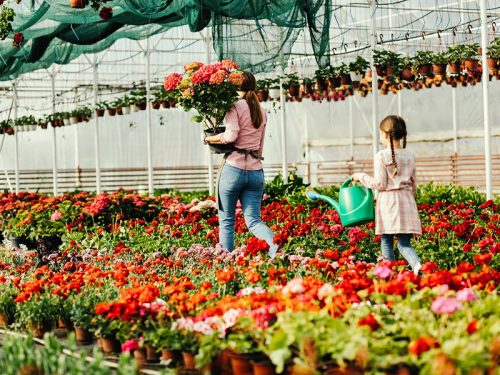Sweet smell of success in floriculture
With the domestic demand for flowers growing at 25 percent annually and offshore demand rising as fast, there’s a great need for qualified individuals in this high potential agri-industry

I t could be roses all the way for youth who opt for careers in floriculture. Incrementally people — especially within India’s expanding middle class — are saying what they have to say with flowers on birthdays, anniversaries, Valentine’s Day, Mother’s Day etc. Little wonder, the floriculture industry, one of the most high-potential sectors in Indian agriculture, is in full bloom.
Floriculture, the art and knowledge of growing flora or flowers, is no longer the preferred hobby of retirees; it’s a fast growing sunrise industry. With the domestic demand for flowers of all shapes and hues growing at 25 percent annually and offshore demand rising as fast, even the somnolent government of India has woken up and accorded the floriculture industry 100 percent export-oriented status to help develop the country into an international hub of flower production, auction, distribution, and retailing.
However, despite being blessed with a facilitating agro-climatic profile, vast land resources, and availability of abundant labour and agricultural scientists, India’s share of global floriculture market is a negligible 0.6 percent. But with several brave entrepreneurs establishing export-oriented floriculture units under controlled climatic (i.e greenhouse) conditions, India is slowly but surely making an impact in the international floriculture market centred in the Netherlands.
Currently the states of Maharashtra, Karnataka, Andhra Pradesh, and Haryana are in the vanguard, with Kerala producing cut flowers and ornamental plants for domestic consumption. Fortuitously, India hosts many exclusive varieties of ornamental flowers, usually exported in the form of seeds or capsules. Roses, marigolds, chrysanthemum, and jasmine are among the popular varieties and about 10,000 hectares of total cultivated area in the country is devoted to growing them.
To prepare for a career in floriculture, the best option is to acquire a four-year B.Sc (horticulture) degree or to study horticulture as a subject in a B.Sc (agriculture) degree programme. Subsequently an M.Sc in horticulture followed by a Ph D and post-doctoral fellowship is ideal. Among the most reputed institutes offering the B.Sc (horticulture) degree programme are:
- College of Horticulture and Forestry, Arunachal Pradesh and Himachal Pradesh
- Kurukshetra University, Kurukshetra
- Shri Venkateshwara University, Tirupathi
- College of Horticulture, Vallanikara, Kerala and Hyderabad
- Horticulture College and Research Institute, Periakulam
- Faculty of Horticulture, TNAU, Coimbatore
- College of Agriculture, Bangalore, Ratnagiri, Akola and Pune
- Aspee College of Horticulture and Forestry, Navsari (Gujarat)
 MARIGOLD BLOOMS. A typical example of a successful new genre floriculturist is Megha Borse, a pioneer woman entrepreneur who has transformed her five-acre farm on the Nasik-Indore road into an export- oriented floriculture unit. Known as the ‘flower power woman of Nasik’, Borse’s farm — Sheelman Flora — which blooms with marigolds the year around, attracts hundreds of visitors from around the country.
MARIGOLD BLOOMS. A typical example of a successful new genre floriculturist is Megha Borse, a pioneer woman entrepreneur who has transformed her five-acre farm on the Nasik-Indore road into an export- oriented floriculture unit. Known as the ‘flower power woman of Nasik’, Borse’s farm — Sheelman Flora — which blooms with marigolds the year around, attracts hundreds of visitors from around the country.
“When I started out in 2004, there were only 10 flora farms in Nasik. Since then, 10-15 are being promoted every year. I am motivating farmers here to grow flowers on part of their land and have promised to take charge of marketing their produce. I believe with sustained encouragement, Nasik could become the next Amsterdam,” says Borse, an M.Sc in organic chemistry from R.V. College, Nasik.
Starting with a 1,008 sq mt polyhouse in 2004 with an investment of Rs.10 lakh, Borse now has three greenhouses yielding 600,000 flowers per year and has acquired the reputation of a knowledgeable floriculture consultant. “Success hasn’t come easy. From laying mud in trenches to tending every flower, I’ve done it all. Floriculture, after all, is an industry and has to be managed in a planned, methodical manner.” says Borse.
Borse also represents Maharashtra in an apex committee constituted by the Union ministry of agriculture, and with the floriculture industry by the Union ministry of agriculture, and with the floriculture industry all set to bloom, she believes there’s growing demand for qualified individuals in this high-potential agri-industry. “This is one of the best career options for graduates who don’t necessarily have to be highly qualified horticulturists to enter this field. Practical experience of a greenhouse and enthusiasm for the subject is good enough for starters. The Horticultural Training Centre near Talegaon set up with Dutch collaboration imparts an excellent five-day training programme in greenhouse management. If several such training centres are provided, establishing floriculture units will become much easier. You need a start-up investment of about Rs.10 lakh to buy a farm. Within three to four months when flowers start to bloom, you could earn a net nontaxable income of around Rs.20,000 per month plus have the satisfaction of being your own boss,” says Borse.
That’s one way to enjoy the sweet smell of success.
To prepare for a career in floriculture, the best option is to acquire a four-year B.Sc (horticulture) degree or to study horticulture as a subject in a B.Sc (agriculture) degree programme
(Excerpted and adapted from 101 Great Careers for the 21st Century by Indra Gidwani)

















Add comment